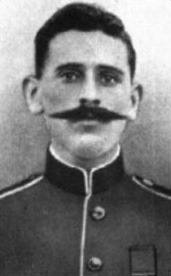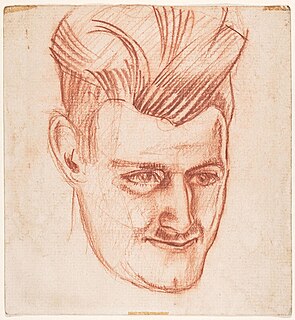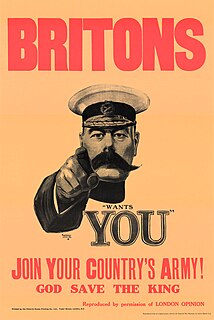
Laventie is a commune in the Pas-de-Calais department in the Hauts-de-France region of France.

Christopher Richard Wynne Nevinson was an English figure and landscape painter, etcher and lithographer, who was one of the most famous war artists of World War I. He is often referred to by his initials C. R. W. Nevinson, and was also known as Richard.

Albert Jacka, was an Australian recipient of the Victoria Cross, the highest decoration for gallantry "in the face of the enemy" that can be awarded to members of the British and Commonwealth armed forces. Jacka was the first Australian to be decorated with the VC during the First World War, receiving the medal for his actions during the Gallipoli Campaign. He later served on the Western Front and was twice further decorated for his bravery.

William Frederick Faulds was a South African soldier, and recipient of the Victoria Cross, the highest and most prestigious award for gallantry in the face of the enemy that can be awarded to British and Commonwealth forces. He was the first South African-born man serving with South African Forces to be awarded the VC.

Sidney William Ware VC was a British recipient of the Victoria Cross, the highest and most prestigious award for gallantry in the face of the enemy that can be awarded to British and Commonwealth forces.
Private Edward Warner VC was an English recipient of the Victoria Cross, the highest and most prestigious award for gallantry in the face of the enemy that can be awarded to British and Commonwealth forces. He was a private in the 1st Battalion, The Bedfordshire Regiment, British Army during World War I, who was posthumously awarded the Victoria Cross for gallantry during the defence of Hill 60 on 1 May 1915.

Ross Tollerton VC born in Hurlford, Ayrshire, was a Scottish recipient of the Victoria Cross, the highest and most prestigious award for gallantry in the face of the enemy that can be awarded to British and Commonwealth forces.

Alfred John Shout, VC, MC was a New Zealand-born soldier and an Australian recipient of the Victoria Cross (VC), the highest decoration for gallantry "in the face of the enemy" awarded to members of the British and Commonwealth armed forces. Shout was posthumously awarded the VC for his actions at Lone Pine in August 1915, during the Gallipoli Campaign of the First World War. After Ottoman forces had counterattacked and seized a large stretch of the Australians' front line, Shout gathered a small party of men and charged down one trench throwing bombs. He killed eight Turkish soldiers, and managed to clear others to retake the trench. In a similar action later that day, and supported by another officer, he recaptured further ground amid hard fighting. In the final push forward, Shout simultaneously lit three bombs to lob at the enemy. He successfully threw two, but the third burst just as it was leaving his hand. Shout was grievously wounded, and died two days later.
John Northcote Nash was a British painter of landscapes and still-lives, and a wood engraver and illustrator, particularly of botanic works. He was the younger brother of the artist Paul Nash.
The 39th Garhwal Rifles was an infantry regiment of the British Indian Army.

Eric Henri Kennington was an English sculptor, artist and illustrator, and an official war artist in both World Wars.

The First World War, which was fought between 1914 and 1918, had an immediate impact on popular culture. In over the hundred years since the war ended, the war has resulted in many artistic and cultural works from all sides and nations that participated in the war. This included artworks, books, poems, films, television, music, and more recently, video games. Many of these pieces were created by soldiers who took part in the war.

William Barnes Wollen was an English painter mostly known for his paintings of battle and historical scenes and sporting events.
James Prinsep Beadle (1863–1947), was an English painter of historical and military scenes. Born in Calcutta on 22 September 1863, his father was Major-General James Pattle Beadle. For three years, he studied with Legros at the Slade School in London and at the Ecole des Beaux Arts in Paris under Alexandre Cabanel; his final studies were back in London with G. F. Watts.
British official war artists were a select group of artists who were employed on contract, or commissioned to produce specific works during the First World War, the Second World War and select military actions in the post-war period. Official war artists have been appointed by governments for information or propaganda purposes and to record events on the battlefield; but there are many other types of war artist.
Joseph Gray was a Durham-born painter and etcher of landscapes, architectural subjects and battlefield scenes. Some of his most evocative work hangs in the Imperial War Museum and different Regimental Museums throughout Britain.

"Over The Top". 1st Artists' Rifles at Marcoing, 30th December 1917 is a 1918 oil-on-canvas painting by John Nash. It depicts a counter-attack on Welsh Ridge in northern France on 30 December 1917, during the First World War. It is held by Imperial War Museum, London.
Ernest Stafford Carlos was a British painter and war artist. He is best known for his works depicting the early days of the Scout Movement. He joined the British Army and was killed during the First World War.

24th East Surrey Division War Memorial is a First World War memorial in Battersea Park, London. The unusual avant-garde design by Eric Kennington, his first public commission, was unveiled in 1924. It became a Grade II* listed building in 2005.
Ellis Luciano Silas was a British artist and draughtsman who served as an ANZAC during the First World War.













